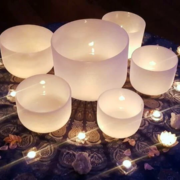UPCOMING EVENTS
Grounded Sound Bath
Saturday December 20th
6:00 pm

Connect with Mother Earth as you immerse yourself in the soothing sound of crystal and Tibetan singing bowls and other meditative instruments for a deeply relaxing & healing inward journey. Grounding mats provided.
*WE HAVE 3 SPACES LEFT*
+++++++++++++
Return of the Light:
Plant Allies for Stress, Depression, and Fatigue
with Kat Maier

Saturday January 31st, 2026, 10am – 5pm
Sunday Morning Tea Ceremonies

with Silvy Franco
Join Silvy for a meditative ceremony to commune with Camelia sinensis. Come for quiet reflection as you sip on several cups of tea following Japanese tradition. Ceremony begins at 9:30 am and goes for an hour. Pre-registration is required.
Suggested Donation: $25




St. John’s Wort
/in Herb of the Month /by Ashley DavisSt. John’s Wort (Hypericum Perforatum)
St. John’s wort is one of the most well-known and least understood herbs. It is famous as an antidepressant and gets pigeonholed as a one-size fits all solution for melancholy, and while it can be helpful for many people, it has so much more to offer than simply boosting one’s mood. Blooming during summer solstice, St. John’s wort is all about the sun, bringing sunshine into our internal landscape, and also helping to protect and heal our skin from sun damage. At Winter Solstice, the darkest time of the year in the Northern Hemisphere, we both honor the dark and celebrate the return of the sun as we enter the upswing of solar energy for the next six months. Powerful, yet gentle enough for daily long-term use, St. John’s Wort helps to strengthen your internal sun, supporting mood, self confidence, digestion, circulation, detoxification and more.
BOTANICAL NAME: Hypericum perforatum
COMMON NAMES: St. John’s Wort, Amber Touch and Heal, Goatweed, Aaron’s beard, Devil’s Scourge, Rosin Rose, Klamath weed, Millipertuis
FAMILY: Hypericaceae
PARTS USED: Flowering tops
ACTIONS AND PROPERTIES: Anti-depressant, anti-inflammatory, antipyretic, relaxing nervine, analgesic, antispasmodic, expectorant, diuretic, antiseptic, antiviral, vulnerary, cardio tonic, hepatoprotective,
USES & INDICATIONS: Historically, in Medieval Europe, St. John’s Wort was used to exorcise demons. In modern times it’s a well-known antidepressant (are depressive thought-forms any different than demons?). Its bright, solar energy increases the internal flame, which strengthens one’s sense of self, confidence and will power. It brings light to dark places, and a bright internal flame is truly the best protection against negative influences. It is considered a protective herb and can protect against viruses and bacterial infections as well as demons attachments or other people’s bad energy.
As an antiviral, St. John’s Wort has been shown to inhibit enveloped viruses, including Herpes simplex types 1 and 2, HIV-1, influenza, measles, hepatitis A and B, rubella, vesicular stomatitis virus and equine infectious anemia virus (7). The volatile oil and flavonoids in St. John’s Wort possess anti-microbial activity. Major anti-bacterial (especially Gm. Positive) and minor anti-fungal actions have been observed in-vitro (13). Topically, extracts inhibit Staph infection and speed the healing time for wounds, including burns (14).
Infused into oil, St. John’s wort is a wonderful burn remedy including first and second degree burns, sunburn and burns from radiation treatment. In addition to relieving the pain, soothing inflammation and promoting tissue healing, it also heals damage to the nerves. It is a wonderful nerve tonic and is indicated for nerve damage, nerve pain, neuropathy, sciatica and shingles (it’s antiviral + analgesic affect on the nerves makes it a one stop shop for the latter). A nervous system trophorestorative, St. John’s wort restores function to the nerves, including the peripheral and enteric nervous system.
Homeopathically St. John’s wort is beneficial for nerve pain, burns and trauma or injury to areas of the body that are rich in nerve tissue. It is indicated for sharp shooting pain, inflammations along the length of the nerve, pinched nerves, and puncture wounds. It also prevents lock jaw and helps reduce pain after surgery. Boericke comments that judicious use of hypericum during surgery can make morphine unnecessary.
As a cardio tonic, St. John’s wort strengthens varicosities, capillary integrity and the elasticity of arteries and veins.
With regard to mood, it does support neurotransmitters, relieves anxiety and tension, relaxes and tones the nervous system and can be helpful for stress, fear, anxiety and mild to moderate depression, particularly in individuals feeling feelings of isolation, lack of community and separation from the rest of the world. It is also very helpful for Seasonal Affective Disorder (S.A.D.) which affects so many people during this dark time of year. While it does not contain vitamin D (vitamin D deficiency is associated with S.A.D.) the solar energy of St. John’s Wort brightens, warms and relaxes. It is great for the winter blues, depression due to chronic anxiety (chronic stress burns out your internal flame), and because it is a pain reliever, St. John’s wort can also be supportive for depression due to chronic pain. It is also regarded as an herb to use where there are menopausal changes triggering irritability and anxiety, but it is known to reduce anxiety or stress during any transition period.
Bright red from a yellow flower! How magical is that?!
The name St John’s Wort refers to the legend that the red spots on the leaves first appeared on the anniversary of St John’s beheading. The red spots were symbolic of his blood. Early Christians believed that by wearing the flower, or placing it under their head during sleep, St John would appear and give blessings. If you look closely at a fresh leaf or flower, or crush one of them between your fingers, you will see the red coloration from the oil around the margin of the leaves and petals.
PREPARATIONS AND DOSAGE: Soluble in water, alcohol, oil
CONTRAINDICATIONS: hypericum should be used with caution during pregnancy due to emmenagogue and abortifacient effects (empirical) and uterine stimulant activity (in vitro, animals). May cause photosensitivity when used internally. Because of its potential as a photosensitive agent, it is advised to use hypericum with caution if one is fair skinned and to use caution with sun exposure when using it. This is speculative and more of a concern with very high doses of hypericin such as 3600 mg standardized extract in a single dose or 1800 mg for 15 days (30). Hypericum is not currently recommended for people with severe depression, at least not as a cure in and of itself. Psychotic symptoms or suicidal risk require professional medical attention. Discontinue use 1 week before surgery (optional) due to potential interactions with anesthetic drugs.
DRUG INTERACTIONS: St. John’s Wort is well known for having a fast transit time in the system so that it will affect other medications taken. In particular, one should not combine with SSRI antidepressants. The following interactions have been documented:
REFERENCES:
***This information is for educational purposes only and is not intended to diagnose or treat any disease***